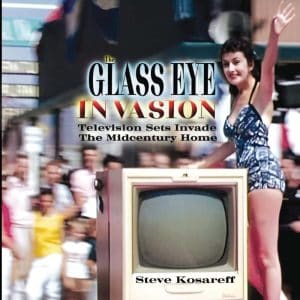 The Glass Eye Invasion is a follow-up and prequel of sorts to Steve Kosareff's 2005 book, “Window to the Future”. The Glass Eye Invasion examines in great detail the arrival of the first sets in American homes during a very short period of time, 1948-53. The book is lushly illustrated with double-page colour immersive spreads with original artwork and many never before published photographs. (View sample pages at https://a.co/d/hEvLzta)
The Glass Eye Invasion is a follow-up and prequel of sorts to Steve Kosareff's 2005 book, “Window to the Future”. The Glass Eye Invasion examines in great detail the arrival of the first sets in American homes during a very short period of time, 1948-53. The book is lushly illustrated with double-page colour immersive spreads with original artwork and many never before published photographs. (View sample pages at https://a.co/d/hEvLzta)
It begins with a deep dive with the introduction of commercial television sets at the 1939 New York and San Francisco World’s Fairs. Then a look at how dealers were educated in preparation for television sales after World War II. A favourite postwar story is the 1947 RCA Television Caravan which crisscrossed the United States with 12 men and women in six Jeep station wagons demonstrating television at twenty-two United Department stores. Another favourite is the 1950 Television Manufacturers Association’s “There Are Some Things a Son or Daughter Won't Tell You!” ad campaign which featured the faces of distraught children whose family didn’t own a television set. Did you know a famous children’s educator’s reputation was almost ruined because of his participation? Did you know Eleanor Roosevelt was forced to take a public stance? The story has as many twists and turns as a whodunit.
Next is a revisit of the shady television set dealers and repairmen who were lying in wait for an unsuspecting public. Once a family decided to buy a television set from a reputable dealer the biggest concern it faced was where to place it—which doesn’t seem much of a problem today—but when taken into account that homes and families weren’t designed at the time for permanent home theatres it was a major issue.
Then there is the hoopla that surrounded the introduction of the television set with contest winners; Miss Television contests at fairs and exhibitions; dealer sidewalk “sales;” television set theft and violence (against sets); owners who were concerned their sets were watching them, or worse, receiving signals from outer space; and jockeying by patrons in bars (which owned the first sets) for the best place to view sporting events. Most importantly, the book looks at how people were concerned that television would impact their families’ lives, especially children’s education.
Finally, full circle and back to David Sarnoff—who started it all at the 1939 Fairs—predicting television’s future in the last chapter entitled, “This Is 1965!” You’ll find The Glass Eye Invasion—Television Sets Invade the Midcentury Home a fascinating, informative, and entertaining experience that you’ll return to time and again. Available on Amazon.ca.

